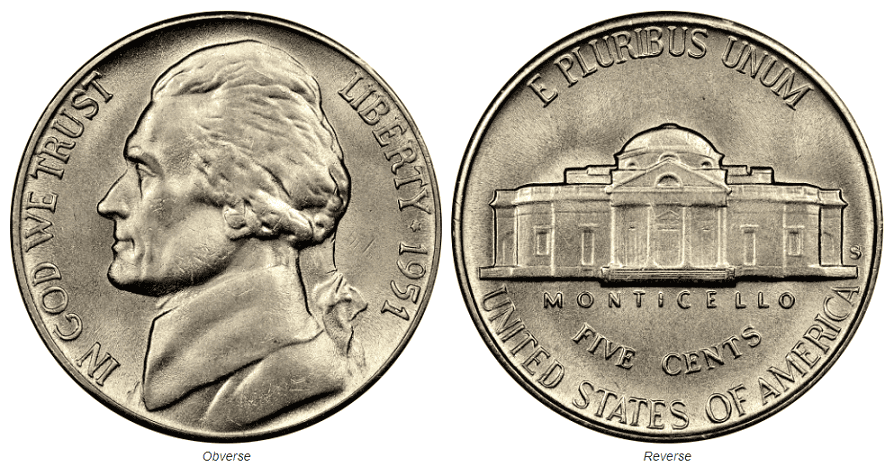The 1951 Jefferson nickel is a 5-cent coin issued by the US Mint in 1951. It is a part of the regular series of the Jefferson nickels that the US Mint started to release in 1938. It has been in production ever since until this day.
While the 1951 nickel has little to no significant numismatic value, many collectors favor this coin. So, if you are one of these collectors who want to learn more about the 1951 nickel, then you need to continue reading.
What Is the 1951 Jefferson Nickel Made Of?
photo source: NGC
The 1951 Jefferson nickel is made of 75% copper and 25% nickel. The US Mint used the same composition from 1938 until now, except from mid-1942 to 1945. During the war, Congress asked the US Mint to save as much nickel as possible since nickel was an important raw material in producing weapons.
As a result, the US Mint used 56% copper, 35% silver, and 9% manganese for the five-cent coin during World War II. The original cupro-nickel composition was then restored after the war.
When it comes to design, as its name suggests, the obverse features the face of Thomas Jefferson, the 3rd president of the United States and also considered one of the Founding Fathers of the nation.
Along with the image of Jefferson are the inscriptions IN GOD WE TRUST, LIBERTY, and 1951.
On the reverse, you’ll find the front view of the Monticello Mansion, which is located in Charlottesville, Virginia. Inscriptions include E PLURIBUS UNUM, MONTICELLO, FIVE-CENTS, and UNITED STATES OF AMERICA.
The beginning of the Jefferson Nickel is quite interesting. Before the Jefferson nickel, the US Mint produced the Buffalo nickel. While the design of this nickel is well regarded today, it was a difficult coin to produce. The die’s lifespan was shorter than usual.
With this in mind, the US Mint immediately replaced the Buffalo nickel as soon as it was legal.
In January 1938, the US Mint held an open design competition for the nickel coin. Eventually, Felix Schlag won, and his design was used for most of the time the Jefferson nickel was issued.
1951 Jefferson Nickel Varieties
In 1951, the Denver, Philadelphia, and San Francisco Mint worked together to produce more than 56.8 million nickels. This is a huge mintage figure compared to the previous year 1950. The US Mint would produce more than 115 million nickels in 1952.
Here’s a quick look at the 1951 Jefferson nickel varieties, along with their mintage:
| Variety | Mint Location | Mintage |
| 1953 D Jefferson Nickel | Denver | 20,460,000 |
| 1953 P Jefferson Nickel | Philadelphia | 28,552,000 |
| 1953 P Proof Jefferson Nickel | Philadelphia | 57,500 |
| 1953 S Jefferson Nickel | San Francisco | 7,776,000 |
| Total | 56,845,500 |
Let us go through each of these nickel varieties in greater detail.
1951 D Jefferson Nickel
Year of minting: 1951
Mint Mark: D
Place of minting: Denver
Quantity produced: 20,460,000
Face Value: $0.05 (five cents)
Price: $0.25 and $0.75 (circulated condition)
Mass: 5.00 grams
Diameter: 21.20 mm
Edge: Plain
Designer: Felix Schlag
Composition: 75% Copper, 25% Nickel
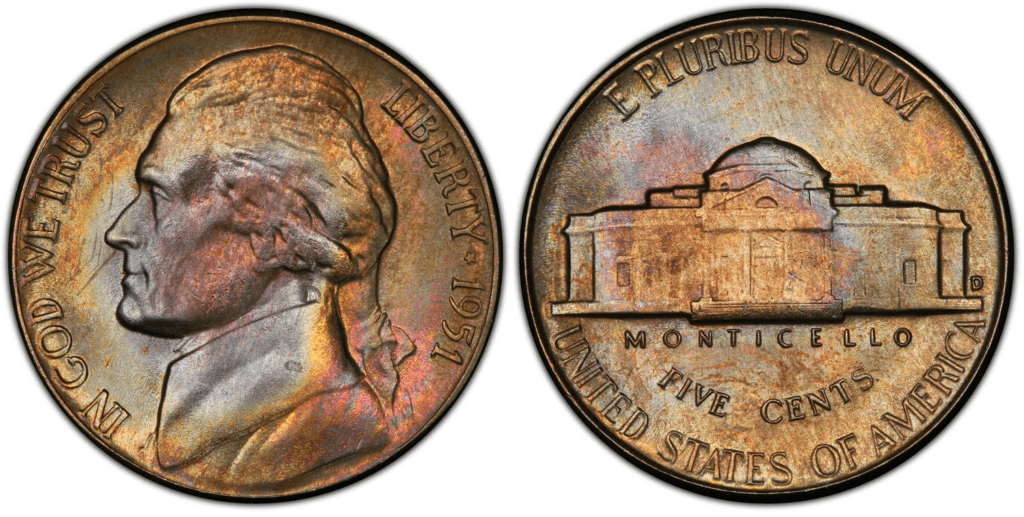
The Denver Mint was known to produce the most well-struck coins among the other Mint Centers. Nevertheless, 1951 was a year of poorly struck nickels. It is rare to find beautiful 1951 nickels but if you want to find one, you could have a better chance if you specifically search among the 1951 D nickels.
1951 P Jefferson Nickel
Year of minting: 1951
Mint Mark: none
Place of minting: Philadelphia
Quantity produced: 20,460,000
Face Value: $0.05 (five cents)
Price: $0.25 and $0.75 (circulated condition)
Mass: 5.00 grams
Diameter: 21.20 mm
Edge: Plain
Designer: Felix Schlag
Composition: 75% Copper, 25% Nickel
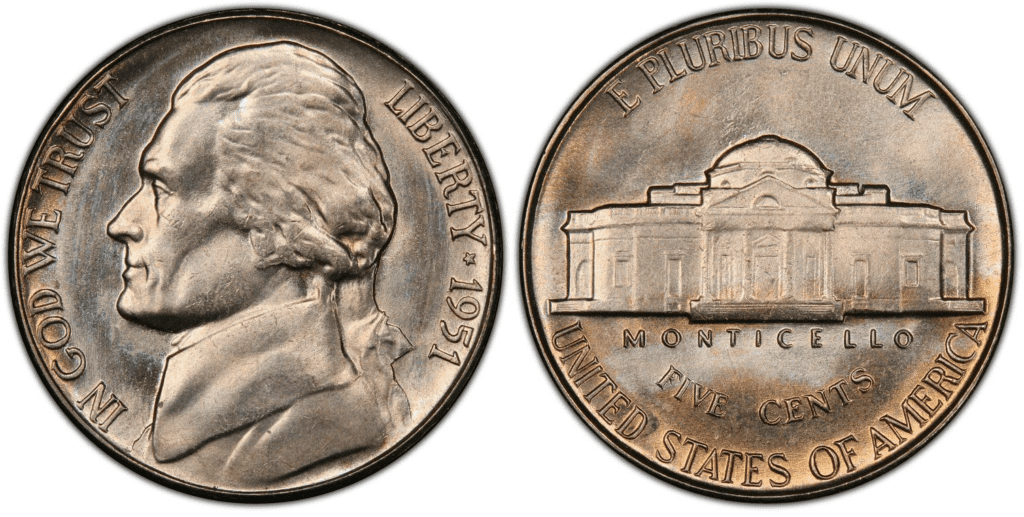
The Philadelphia Mint produced the most nickels with its 1951 P variant. This coin is set apart from other 1951 nickels because it has no mint mark.
Buying or selling a 1951 P nickel is affordable and ranges from $0.25 to $0.75. Of course, that’s the price of circulated 1951 P 5-cent coins. It can be higher if the coin is still in good condition.
1951 P Proof Jefferson Nickel
Year of minting: 1951
Mint Mark: none
Place of minting: Philadelphia
Quantity produced: 57,500
Face Value: $0.05 (five cents)
Price: 25 or more (uncirculated condition)
Mass: 5.00 grams
Diameter: 21.20 mm
Edge: Plain
Designer: Felix Schlag
Composition: 75% Copper, 25% Nickel
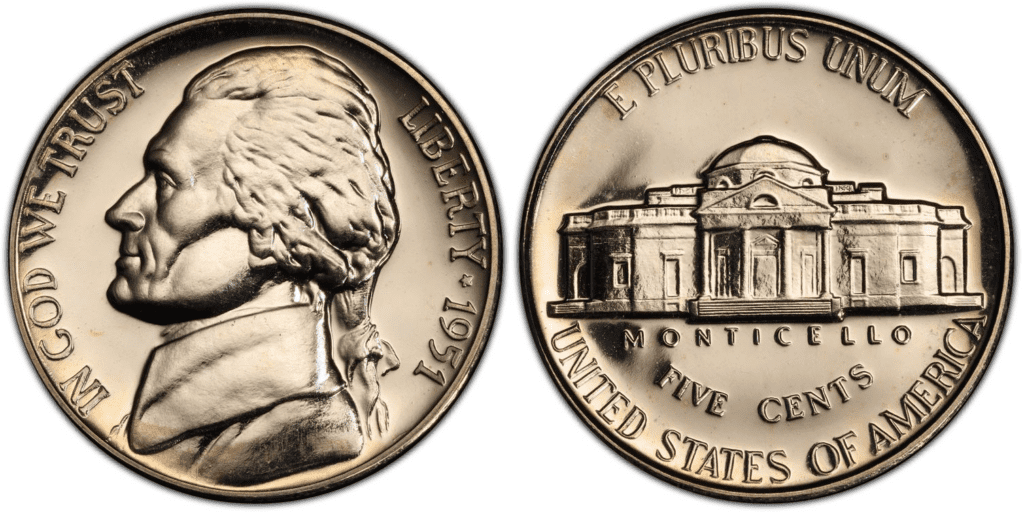
Aside from the regular nickels, the Philadelphia Mint also produced proof coins. In 1951, there were about 57 thousand proof coins which were sold or given to collectors.
The 1951 nickel-proof coins are hand-polished, treated, and cleaned to produce the finest quality. Because of how the proof coins were produced, they are usually more expensive than ordinary nickels.
1951 S Jefferson Nickel
Year of minting: 1951
Mint Mark: S
Place of minting: San Francisco
Quantity produced: 7,776,000
Face Value: $0.05 (five cents)
Price: $0.50 to $1.25 (circulated condition)
Mass: 5.00 grams
Diameter: 21.20 mm
Edge: Plain
Designer: Felix Schlag
Composition: 75% Copper, 25% Nickel
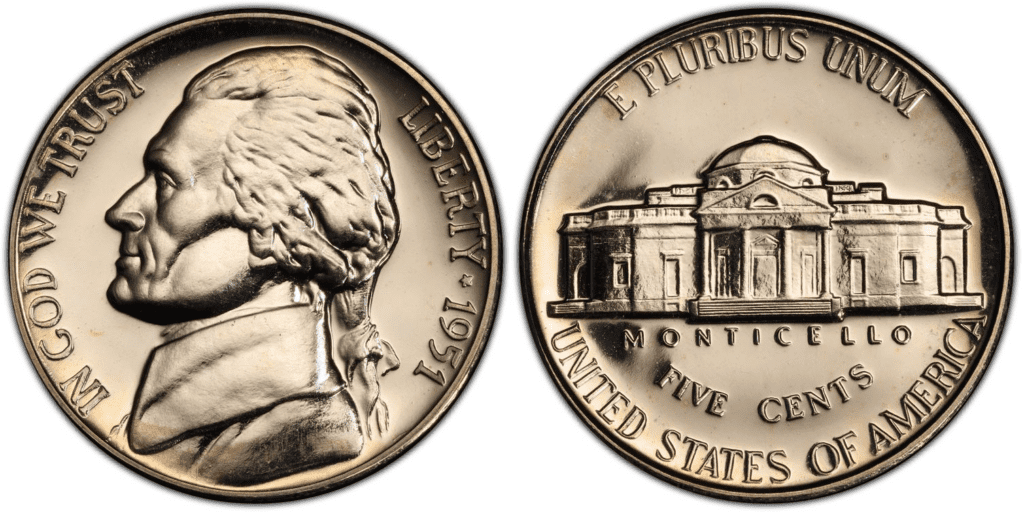
The San Francisco Mint produced more than 7 million nickels in 1951, which is a good number considering that the San Francisco Mint didn’t produce any nickels in 1950. The San Francisco Mint exerted more effort in 1952 and produced more than 20 million nickels.
Because the 1951 S nickel is rarer than the nickels produced in Denver and Philadelphia, it is slightly more expensive than the other standard variants.
List Of 1951 Jefferson Nickel Errors
As mentioned, about 56 million 1951 nickels were issued by the US Mint; producing thousands of nickels daily could also lead to producing error coins. The 1951 nickel has its fair share of error coins. Here are some examples worth noting:
Doubled die obverse/reverse
The doubled die error can either happen on the obverse (DDO) or the reverse (DDR). The error can also happen on both sides of the coin. The DDO or DDR error can happen when the design elements of the coin are struck twice, creating a blurry or doubled image.
DDR and DDO errors of the 1951 Jefferson can be rare. If you find one with a prominent doubling image, the coin’s value can astronomically soar.
Repunched Mintmark
The mintmark is separately punched into the coin. Because of this, there’s a chance that the mintmark is punched twice while the rest of the engraved elements are normally struck.
A repunched mintmark is commonly referred to as RPM. Here’s an example of an RPM error in a 1951 nickel:
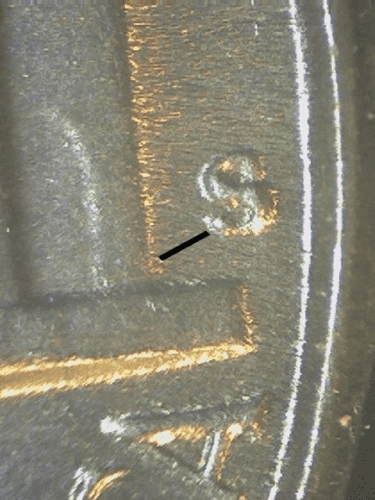
You’ll find some doubling effect on the S mint mark.
RPM errors can only be seen on the S and D nickel variants since Philadelphia doesn’t have mint marks on the coins they produced.
Off-Center Strike
An off-center strike can happen when the die hits the planchet at the wrong angle. Because of that, some parts of the nickel’s design are cut off or missing. The off-center strike is due to the misalignment of the die and planchet.
Here’s an example of an off-center strike error:
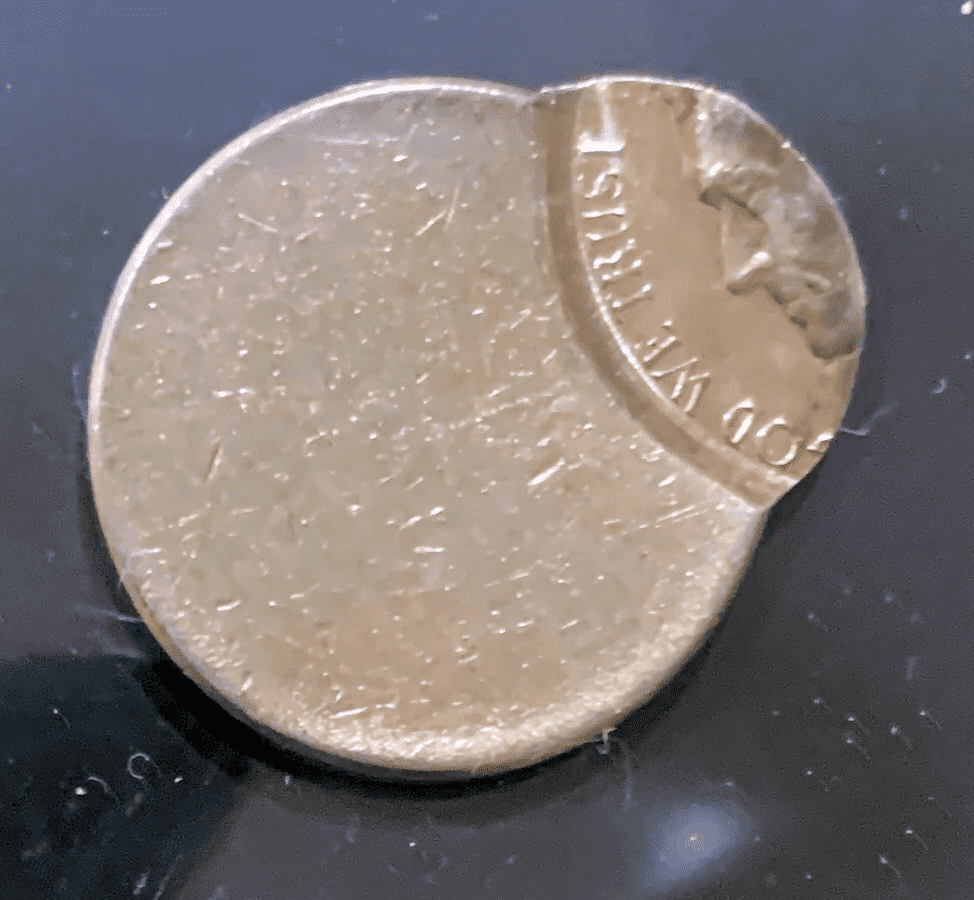
Die Breaks
As you can imagine, the die hits the planchet multiple times daily. Given enough time, the die could break, and when this happens, the crack on the die can be imprinted on the coin.
Die breaks could result in raised lines or blobs on the coin’s surface. These errors manifest themselves anywhere on the coin’s surface. Die-break error coins can be valuable depending on the uniqueness and rarity of the coin.
How Much Is The 1951 Jefferson Nickel Worth Today?
The 1951 Jefferson nickel is not made of any precious metals. Thus, it can be traded at its face value of 5 cents. The melt value is slightly higher at $0.0674.
A circulated 1951 five-cent coin can be valued at around $0.50 to $1. An uncirculated coin, meaning it has never been used, can be around $1 to $3.
The value of the 1951 Jefferson nickel can go up or down depending on its condition, errors, and mint mark.
Nevertheless, to give you an idea of the great potential of the 1951 Jefferson nickel, you should check out this table of auction records for each variety:
| Coin | Condition | Grade | Sold date | Sold by | Value |
| 1951 S Jefferson Nickel | Superb Gem Uncirculated – Full Steps | MS 67 | October 30, 2018 | Stack’s Bowers | $18,600 |
| 1951 P Jefferson Nickel | Superb Gem Uncirculated – Full Step | MS 67 | February 27, 2014 | Heritage Auctions | $16,450 |
| 1951 Proof Jefferson Nickel | Superb Gem Uncirculated – Deep Cameo | PR 67 | January 1, 2007 | Heritage Auctions | $10,350 |
| 1951 D Jefferson Nickel | Superb Gem Uncirculated – Full Steps | MS 67 | August 25, 2021 | Stack’s Bowers | $5,760
|
How Does The Grading System Work?
The 1951 nickel is graded the same way as other US coins.
Professional numismatists joined together in the 1970s and established CoinGrading standards. These numismatists now assign grades at key places on the seventy-point scale, using the most regularly utilized numeric points in conjunction with the original adjective grade. The following are the most common coin grades:
- (P-1) Poor – Indistinguishable and probably damaged; if used, must have a date and mintmark; otherwise, rather battered.
- (FR-2) Fair – Nearly smooth, but without the damage that a coin graded Poor often possesses. The coin must have enough detail to be identified.
- (G-4) Fair – Inscriptions have merged into the rims in some areas, and important elements have been mostly erased.
- (VG-8) Very Good- A little weathered, but all primary design elements are visible, albeit faintly. There is little, if any, central detail left.
- (F-12) Good – The item is very worn, yet the wear is even, and the overall design details stand out clearly. Rims are almost completely isolated from the field.
- (VF-20) Very Fine – Moderately weathered, with some finer features still visible. The motto or all letters of LIBERTY are readable. Both sides of the coin have entire rims separated from the field.
- (EF-40) Extremely Fine – Gently used; all gadgets are visible, and the most important ones are bold. The finer details are bold and clear; however, light wear may be seen.
- (AU-50) Uncirculated – Slight evidence of wear on the coin’s design’s high points; it may have contact marks; eye appeal should be adequate.
- (AU-58) Uncirculated Choice – Slight traces of wear, no severe contact marks, almost full mint shine, and great eye appeal.
- (MS-60) Mint State Basal – Strictly uncirculated; no indication of wear on the coin’s highest points, but an unsightly coin with reduced luster, visible contact marks, hairlines, and other flaws.
- (MS-63) Mint State Acceptable – Uncirculated, but with contact scratches and nicks, little reduced shine, but otherwise appealing appearance. The strike is weak to average.
- (MS-65) Mint State Choice – Uncirculated with great mint shine, little contact blemishes, and exceptional eye appeal. The strike is unusually severe.
- (MS-68) Mint State Premium Quality – Uncirculated with superb luster, no obvious contact marks to the naked eye, and exceptional eye appeal. The strike is quick and appealing.
- (MS-69) Almost Perfect Mint State – Uncirculated with perfect brilliance, a sharp and appealing strike, and extremely good eye appeal. A near-perfect coin with minor imperfections in the planchet, strike, and contact markings (seen only under 8x magnification).
- (MS-70) Mint State Perfect – Under 8x magnification, no tiny imperfections are discernible; the strike is crisp, and the coin is perfectly centered on a beautiful planchet. Rarely seen on a coin, this coin is bright and whole, with original luster and exceptional eye appeal.
Specifically for the 1951 nickel, there’s a grading designation called “Full Steps.” A coin can have a Full Steps designation if five to six steps are visible on the Monticello. A Full Steps designation indicates that the coin is fully struck, and thus, it is generally more valuable.
Where To Buy Or Sell 1951 Jefferson Nickel?
The 1951 Jefferson nickel is available on the Internet. You can go to Google, search “Buy 1951 Jefferson nickel” or “Sell 1951 Jefferson nickel,” and have many relevant results.
To help you get started, you can jump immediately to eBay and Amazon. These websites are best known for offering US coins, which could include 1951 Jefferson nickels. Moreover, the same websites allow you to sell your 1951 five-cent coin.
You can also visit coin shops, antique stores, and auction houses. People in these places may sell or buy 1951 Jefferson nickel.
FAQs
Is a 1951 nickel made of silver?
No, the 1951 nickel is not made of silver. Instead, it is made of 75% copper and 25% nickel.
Where is the mint mark on a 1951 nickel?
The mint mark on a 1951 nickel is found on the obverse side of the coin. You should find it between the rim and the left side of the Monticello. A mint mark can be a letter S or D.
What is a 1951 nickel worth today?
The 1951 nickel is worth five cents if you base it on its face value. However, it could be worth hundreds or thousands of dollars if it is in good condition, doesn’t show signs of wear, and possesses rare attributes. To give you an idea, a 1951 S nickel was sold for $18,600 in October 2018.

